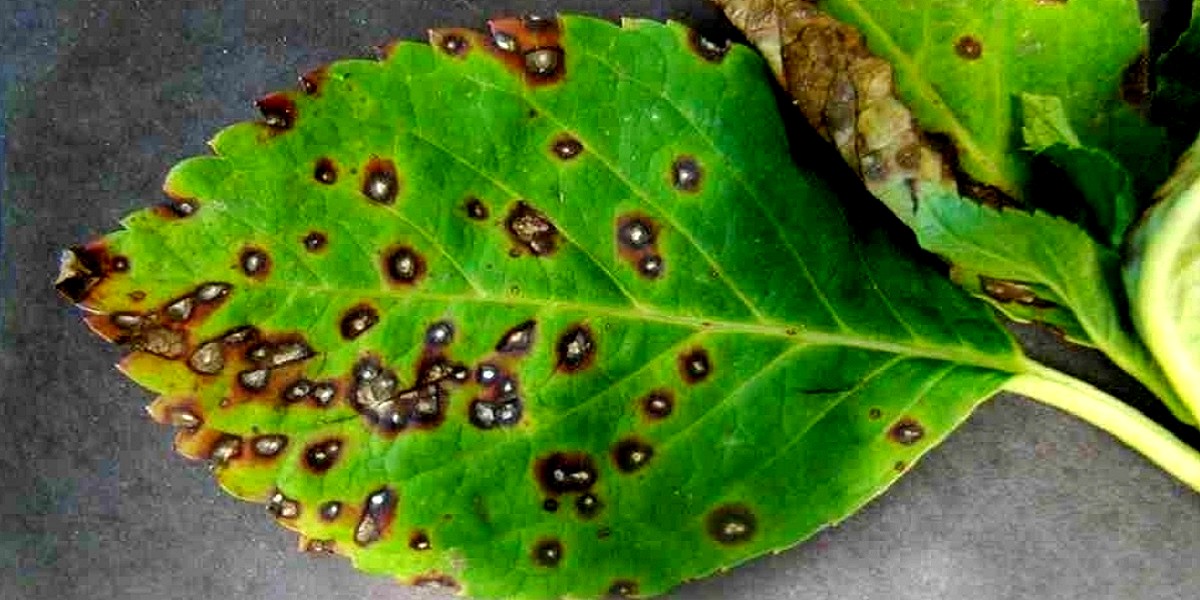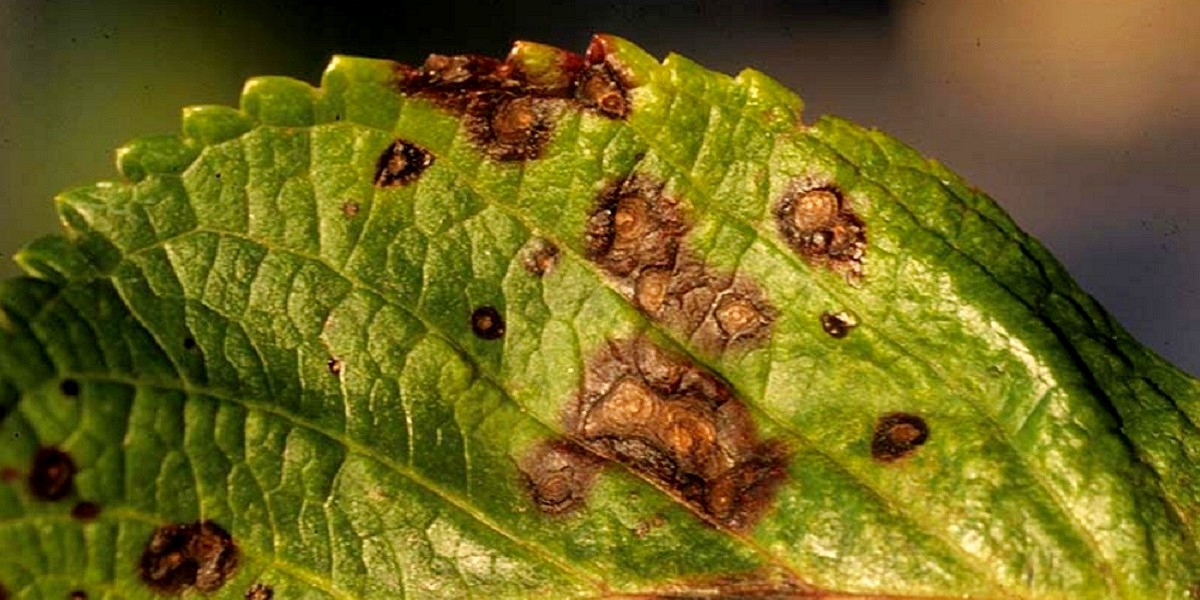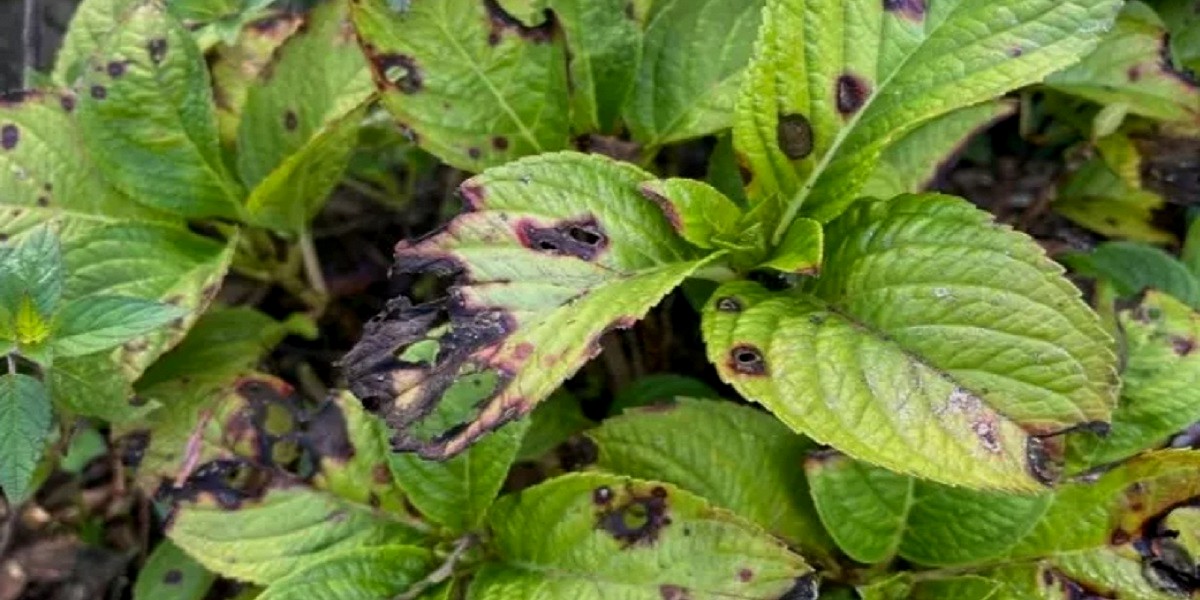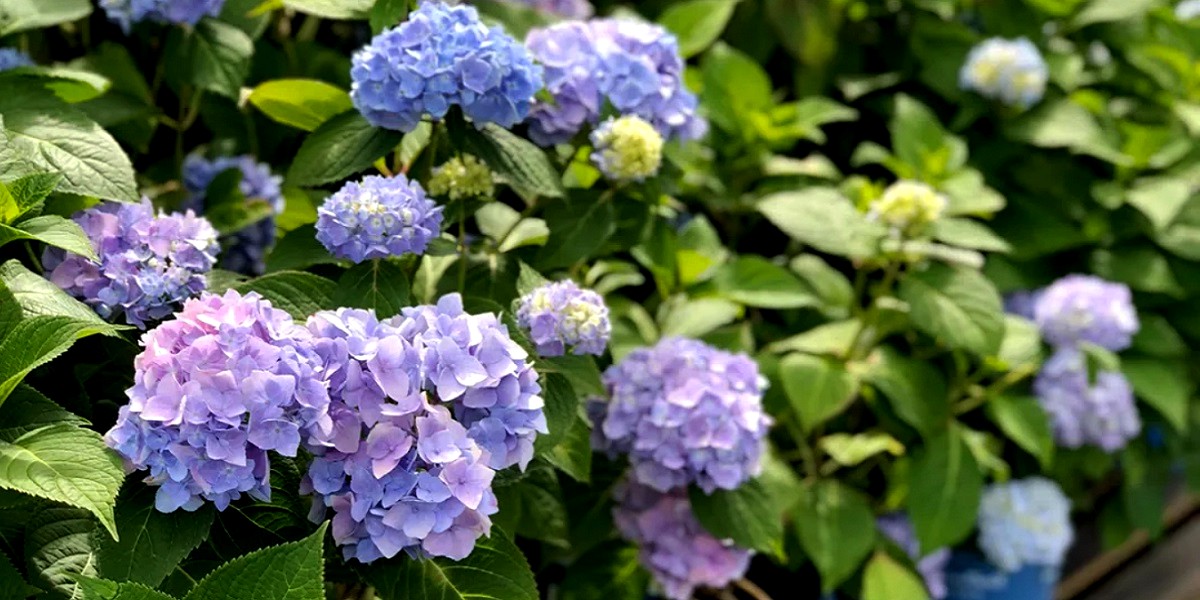Hydrangea is one of the most beautiful flowers that decorate the yards of billions of people around the world. It is simple to take care of and not needy. Moreover, even one plant can decorate your house and make it look stylish. Yet, black spots on hydrangea leaves can ruin all the beauty in no time. They not only damage the total view they get inside the plant and slowly kill it. This disease can be easily spread around other flowers.
Once you notice dark spots on hydrangea leaves, you have to identify the disease. To do it, read this article. You can also download the specific app and share the photo with the leaves. Include the description of the symptoms and you will receive your diagnosis. Since there is more than one disease that can look similar on the leaves, you have to be careful and not start treatment until you are totally sure which disease you are dealing with.
About Black Spots on Hydrangea
Among all plant diseases affecting hydrangea, black spots are the most visible. Basically, there are two types of diseases that infect the flower causing the black spots. They are both fungal. You may find similarities between Anthracnose and Cercospora leaf spots.
Cercospora leaf spot
This disease is visible by the black dots on hydrangea leaves. Usually, it appears in an area with a high level of humidity in the air. If the rains are regular in your location, there is a big chance that this fungal disease will attack your hydrangeas. Cercospora infects mainly fragile flowers. It quickly spreads on the whole plant. The disease affects the leaves first. The first signs are black and purple dots on leaves. Apart from that, there may be spots on the base of the flower.

These spots are circular and small. You can recognize black spot diseases by measuring these scattered dots. They can be 1/8-1/4 inches in diameter. They usually have gray or tan centers that are surrounded by purple or yellow circles.
Once the disease progresses without any cure, the leaves begin to turn from green to yellow and brown. After some time, they fall down. This disease rarely kills the plant. Yet, it can slow down hydrangea’s growth and leave the flower leafless. Apart from that the plant may lose all its original charm and ruin the view of your yard.
Anthractnose
Among hydrangeas plant diseases, Anthractnose happens more rarely than Cercospora. Apart from that, it does not affect all the species. Instead, its prime target is the bigleaf hydrangea or Hydrangea macrophylla, known as French or mophead among gardeners. You may recognize them by impressive balls of flowers in pink, blue, white, or red colors. Usually, this type of fungal disease appears in big greenhouses and spread from one flower to another. Yet, there is still a possibility that the illness will infect your hydrangea that grows outdoors.
What causes the disease? Anthractnose is provoked by Colletotrichum gloeosporioides fungus. It attacks both blossoms and leaves. The best conditions you can provide for this disease is to overwater the flower and plant other hydrangeas too close to each other. This way the flower will suffocate and the fungus will spread in no time. If you don’t want to witness the slow death of your favorite plants you have to make sure you don’t water them too often and there is a space for the wind flow between each flower. You also need to fertilize the plant to boost its immune system.

The disease looks very similar to the previous one at the beginning. You will notice the dark brown spots on the leaves. They are circular but can be irregular just slightly. The center of the spot is close to 1 inch in diameter and is light brown or tan. It is surrounded by a darker circle. The more illness progresses, the lighter tissue becomes near these circles, dying from fungus. It looks more like a bull’s eye in the end. The spots are getting larger, spreading around the leaf. It turns into angular shapes.
If the disease progresses the big dark circles spread on all leaves and the petals. It stops looking like Cercospora and loses the round shape of the spots. The symptoms occur at the same time on blooms and leaves.
Symptoms of Disease
As you have probably noticed already, there are two types of black spots. The classification of disease can be complicated by the lack of knowledge. If you are not sure about your conclusions on disease, it is better to download the photo inside the app and find out why your hydrangea suffers and how you can treat it.
There are specific reasons why fungus appears on plants. Here they are:
- Poor air circulation. The flowers are growing too close to each other, and you have to replant them;
- High humidity level. As we have previously discussed, the fungus likes humid air;
- Stems and branches grow really close to each other that speeding up the transmission of disease;
- Sprinklers water the leaves too often. It is better to lower down their heads and make sure that they sprinkle only soil and not overwater it;
- Too much rain. You can’t control this natural process. Yet, if you know that there are a lot of rains during the season, it is better to place your hydrangeas in the greenhouse or create a specific cover for it;

If you are not sure which disease you have, you need to look close to the plant. Even black spots can be different. Yet, the knowledge of what to look for and where can save the flower. Check out the next symptoms:
- Small dark, black, purple, or brown circles on the leaves. They usually appear on the leaves but can be sometimes found under them;
- Infected leaves lose their colors. The disease cycle starts with the small spots on juicy green leaves. Once the illness progresses and the fungus spreads the spots are getting darker and bigger while the green color is gone. They turn yellow or brown;
- The leaves are shedding. They are falling down after getting the dark spots and losing their color. This is the next stage in the disease;
- Petals are getting black spots and falling down in the case of Anthractnose disease. This is one of the major differences. Cercospora does not have a similar effect.
Methods of Prevention and Treatment
Before you have to start treatment, it is always the time when you can use preventive measures. They are not that hard to provide and will save the leaves on your hydrangeas in the first place. This is how you can prevent bacteria from spreading:
- Cut the old stems. If you are worried about the flower, don’t worry, it will only provide extra space that it needs for growth. Moreover, the airflow will be better. No matter of hydrangea types, they all need thinning the stems at the beginning of Spring. Remove the old ones and make a room there. However, you can’t remove over 1/3 stems. Follow this rule, and your plants will grow in no time. If you missed the timing, you can always cut the plant during the flowering. Make sure you use sterilized scissors;
- Although it may be appealing to use all fertilizers at once to make sure your plant will be healthy, try to avoid the temptation. No matter if you grow an indoor plant or an outdoor one, you have to follow the instructions provided by developers. Too many nutrients can make the flower fragile. Pick the natural treatment with the slow release of nutrients for your plants. Natural fertilizer is more helpful than chemical for hydrangea;
- Avoid overhead sprinklers. These sprinklers pour the water on the leaves, increasing the chances of the fungus development. It is better to use a simple garden hose if you have outdoor plants. For houseplants, you simply have to pout the water right to the soil. If you have sprinklers, it is better to turn them on during the morning hours when the sun shines brightly and can dry the leaves;
- Always throw away leaves that you cut. Leaves that contain disease must be immediately removed and destroyed. The fungus inside of them can easily survive for some time on those leaves until it finds a better host. Never bring them to the compost since you can forget and later create mulch from it;
- You have to clean all the leaves that fell down during the late fall. Make sure that there is nothing left near the plant. Hydrangeas need to take some rest before the spring.

Treatment
If the preventive measures did not work or you notice the problem too late, you have to learn how to treat the disease. Since there is no guarantee that your hydrangeas are resistant to black spots, it is better to look for remedies in advance. Here are your next moves:
- You have to get rid of all the infected leaves. Start with a natural remedy that everyone can use and which costs nothing. You have to cut down all the leaves that were infected in the first them. Once you cut them, gather everything and burn. Do not throw it away in the compost pile. If you have several hydrangeas that are infected, disinfect scissors with alcohol before you go from one plant to another so the fungus would not spread even more. If you will hesitate and wait, you will need to remove stems together with leaves;
- Cut the stems for better circulation of the air. You can use it as a preventive measure or a treatment. If the plant is infected, you still have to cut it;
- Replant one hydrangea that is affected by the disease from others. Make sure you don’t plant anything in this soil for some time. The fungus can survive there. Once you separate the diseased plant, check out for the leaves it could drop down;
- Spray the plants with a mix of baking soda and water. You need to make sure that the disease does not go to other plants. Repeat the procedure once a week until you notice that the new black spots do not appear on the leaves;
- Neem oil. Although it is considered to be the natural solution, use a limited amount of oil. The oil is made of the seed gathered from the neem tree. It can burn leaves getting inside their structure. Spray it carefully on the plant. It is better to mix neem oil with water. Do not apply it too often or too much;
- Use the fungicide. You can pick a specific fungicide for hydrangea. There is a wide range of options on the market. Some fungicides are chemical-free others contain chemicals like copper soap. Decide which one you need the most. It is usually based on the level of infestation. If the leaves are almost completely covered with black spots and start to fall down you can’t hesitate any longer. You need to kill the fungus that lives inside the plant. The major problem with waiting till the first signs of the problem appears is that they usually don’t appear till the end of summer. The best option is to spray the flower with fungicide based on copper. You can do it even in preventive measures. Use the fungicide on the new leaves every 14 days. If the same plant had a black spot problem last year, you can use fungicide with copper every 10 days during the early spring.
If you just want to buy hydrangeas for your garden, you can ask the seller for the disease-resistant type. It will help you to avoid numerous problems in the future. However, you need to keep in mind that you still need to be careful since many black spot fungi can mutate with time. Apart from that, it is always better to keep the plant healthy, so that itcould resist any other illnesses on its way. Using the right fertilizer on the disease-resistant hydrangea will help you to achieve outstanding results and grow beautiful flowers.
Growing Hydrangea Without Black Spots
Your hydrangeas would not decorate your garden without an effort from you. Although the flowers are beautiful on their own, you still have to make sure that the plant is healthy and grows normally. These tips above will help you to find out which type of black spots your hydrangea has and how to prevent them. There are numerous recommendations for preventive measures as well as treatment. Take them seriously and pick those that suit your current problem.
If you can’t identify the disease by yourself, don’t risk the plant safety, use the app to find out the type of fungus and how to treat it. All you need is to download the photo and check out the symptoms. Once you learn how to treat your flowers properly you will be able to grow the most beautiful species in the whole neighborhood.
Leave a Reply
You must be logged in to post a comment.